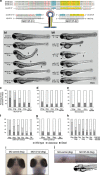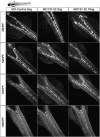Developmental suppression of schizophrenia-associated miR-137 alters sensorimotor function in zebrafish
- PMID: 27219344
- PMCID: PMC5070046
- DOI: 10.1038/tp.2016.88
Developmental suppression of schizophrenia-associated miR-137 alters sensorimotor function in zebrafish
Abstract
The neurodevelopmentally regulated microRNA miR-137 was strongly implicated as risk locus for schizophrenia in the most recent genome wide association study coordinated by the Psychiatric Genome Consortium (PGC). This molecule is highly conserved in vertebrates enabling the investigation of its function in the developing zebrafish. We utilized this model system to achieve overexpression and suppression of miR-137, both transiently and stably through transgenesis. While miR-137 overexpression was not associated with an observable specific phenotype, downregulation by antisense morpholino and/or transgenic expression of miR-sponge RNA induced significant impairment of both embryonic and larval touch-sensitivity without compromising overall anatomical development. We observed miR-137 expression and activity in sensory neurons including Rohon-Beard neurons and dorsal root ganglia, two neuronal cell types that confer touch-sensitivity in normal zebrafish, suggesting a role of these cell types in the observed phenotype. The lack of obvious anatomical or histological pathology in these cells, however, suggested that subtle axonal network defects or a change in synaptic function and neural connectivity might be responsible for the behavioral phenotype rather than a change in the cellular morphology or neuroanatomy.
Figures





Similar articles
-
Slow degeneration of zebrafish Rohon-Beard neurons during programmed cell death.Dev Dyn. 2004 Jan;229(1):30-41. doi: 10.1002/dvdy.10488. Dev Dyn. 2004. PMID: 14699575
-
Long-lived zebrafish Rohon-Beard cells.Dev Biol. 2020 Aug 1;464(1):45-52. doi: 10.1016/j.ydbio.2020.05.003. Epub 2020 May 27. Dev Biol. 2020. PMID: 32473165
-
[Knockdown and overexpression of miR-219 lead to embryonic defects in zebrafish development].Fen Zi Xi Bao Sheng Wu Xue Bao. 2008 Oct;41(5):341-8. Fen Zi Xi Bao Sheng Wu Xue Bao. 2008. PMID: 19127769 Chinese.
-
MicroRNA 19a replacement partially rescues fin and cardiac defects in zebrafish model of Holt Oram syndrome.Sci Rep. 2015 Dec 14;5:18240. doi: 10.1038/srep18240. Sci Rep. 2015. PMID: 26657204 Free PMC article.
-
Decrease in levels of the evolutionarily conserved microRNA miR-124 affects oligodendrocyte numbers in Zebrafish, Danio rerio.Invert Neurosci. 2015 Sep;15(3):4. doi: 10.1007/s10158-015-0180-1. Epub 2015 Jul 10. Invert Neurosci. 2015. PMID: 26159098
Cited by
-
Mutant zebrafish lacking slc25a22a show spontaneous seizures and respond to the anti-seizure medication valproic acid.Dis Model Mech. 2025 Jun 1;18(6):dmm052275. doi: 10.1242/dmm.052275. Epub 2025 Jun 20. Dis Model Mech. 2025. PMID: 40539845 Free PMC article.
-
Advances in Zebrafish as a Comprehensive Model of Mental Disorders.Depress Anxiety. 2023 Jun 20;2023:6663141. doi: 10.1155/2023/6663141. eCollection 2023. Depress Anxiety. 2023. PMID: 40224594 Free PMC article. Review.
-
MiR-137: an important player in neural development and neoplastic transformation.Mol Psychiatry. 2017 Jan;22(1):44-55. doi: 10.1038/mp.2016.150. Epub 2016 Sep 13. Mol Psychiatry. 2017. PMID: 27620842 Free PMC article. Review.
-
Genomic Editing of Non-Coding RNA Genes with CRISPR/Cas9 Ushers in a Potential Novel Approach to Study and Treat Schizophrenia.Front Mol Neurosci. 2017 Feb 3;10:28. doi: 10.3389/fnmol.2017.00028. eCollection 2017. Front Mol Neurosci. 2017. PMID: 28217082 Free PMC article. Review.
-
Neurexins in autism and schizophrenia-a review of patient mutations, mouse models and potential future directions.Mol Psychiatry. 2021 Mar;26(3):747-760. doi: 10.1038/s41380-020-00944-8. Epub 2020 Nov 15. Mol Psychiatry. 2021. PMID: 33191396 Review.
References
-
- Stefani G, Slack FJ. Small non-coding RNAs in animal development. Nat Rev Mol Cell Biol 2008; 9: 219–230. - PubMed
-
- Ambros V. The functions of animal microRNAs. Nature 2004; 431: 350–355. - PubMed
-
- Lewis BP, Burge CB, Bartel DP. Conserved seed pairing, often flanked by adenosines, indicates that thousands of human genes are microRNA targets. Cell 2005; 120: 15–20. - PubMed
Publication types
MeSH terms
Substances
LinkOut - more resources
Full Text Sources
Other Literature Sources
Molecular Biology Databases

